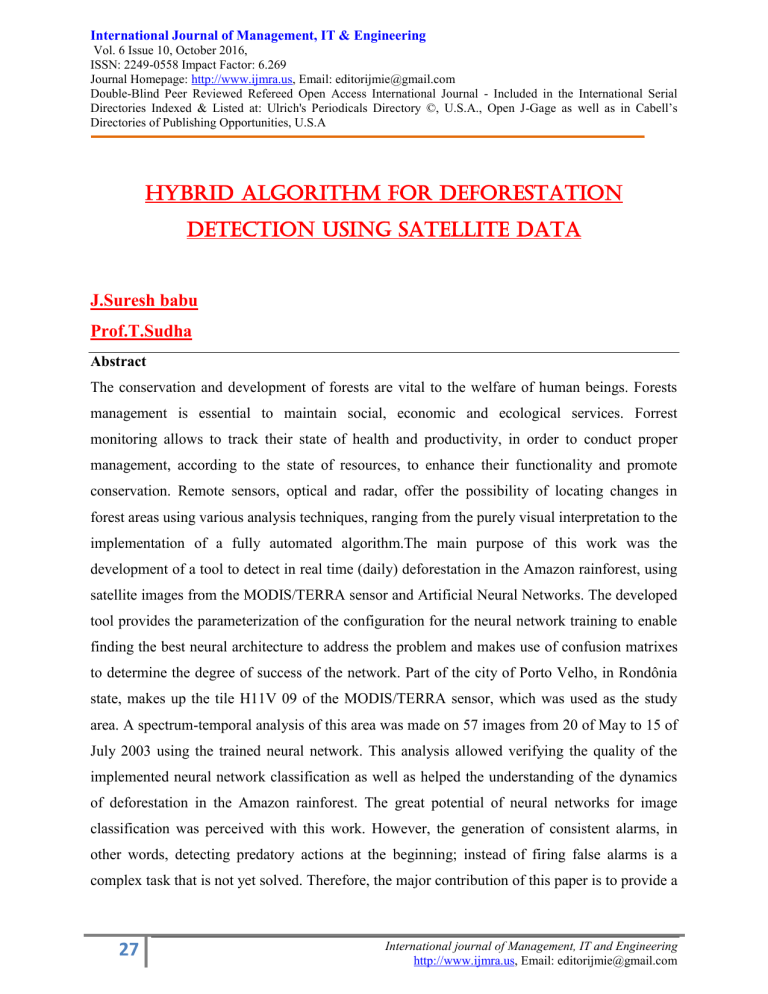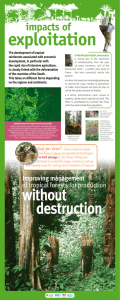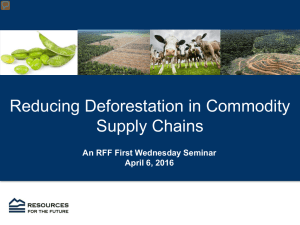IJMRA-10501

International Journal of Management, IT & Engineering
Vol. 6 Issue 10, October 2016,
ISSN: 2249-0558 Impact Factor: 6.269
Journal Homepage: http://www.ijmra.us
, Email: editorijmie@gmail.com
Double-Blind Peer Reviewed Refereed Open Access International Journal - Included in the International Serial
Directories Indexed & Listed at: Ulrich's Periodicals Directory ©, U.S.A., Open J-Gage as well as in Cabell’s
Directories of Publishing Opportunities, U.S.A
HYBRID ALGORITHM FOR DEFORESTATION
DETECTION USING SATELLITE DATA
J.Suresh babu
Prof.T.Sudha
Abstract
The conservation and development of forests are vital to the welfare of human beings. Forests management is essential to maintain social, economic and ecological services. Forrest monitoring allows to track their state of health and productivity, in order to conduct proper management, according to the state of resources, to enhance their functionality and promote conservation. Remote sensors, optical and radar, offer the possibility of locating changes in forest areas using various analysis techniques, ranging from the purely visual interpretation to the implementation of a fully automated algorithm.The main purpose of this work was the development of a tool to detect in real time (daily) deforestation in the Amazon rainforest, using satellite images from the MODIS/TERRA sensor and Artificial Neural Networks. The developed tool provides the parameterization of the configuration for the neural network training to enable finding the best neural architecture to address the problem and makes use of confusion matrixes to determine the degree of success of the network. Part of the city of Porto Velho, in Rondônia state, makes up the tile H11V 09 of the MODIS/TERRA sensor, which was used as the study area. A spectrum-temporal analysis of this area was made on 57 images from 20 of May to 15 of
July 2003 using the trained neural network. This analysis allowed verifying the quality of the implemented neural network classification as well as helped the understanding of the dynamics of deforestation in the Amazon rainforest. The great potential of neural networks for image classification was perceived with this work. However, the generation of consistent alarms, in other words, detecting predatory actions at the beginning; instead of firing false alarms is a complex task that is not yet solved. Therefore, the major contribution of this paper is to provide a
27 International journal of Management, IT and Engineering http://www.ijmra.us
, Email: editorijmie@gmail.com
ISSN: 2249-0558
Impact Factor: 6.269 theoretical basis and practical use of neural networks and satellite images to combat illegal deforestation.
1.
Introduction
Forests provide support for one billion people that live in extreme poverty around the world, and provide remunerative employment to more than one hundred million. They contain more than
80% of terrestrial biodiversity (FAO, 2012) and provide essential environmental services such as soil conservation, watershed management, protection against floods and landslides, and provide industrial wood (UN). According to the International Tropical Timber Organization (ITTO) of the UN, it is estimated that deforestation and forest degradation rise 12.9 million hectares per year and the current area of degraded forest is 850 million hectares. Most of the changes in forestbased ecosystems due to: a) conversion of land cover, b) land degradation c) intensification of land use (Lambin, 1997). These changes have resulted in coverage to a wide variety of ecological impacts, ranging from local to global scale, including changes in productivity and forests composition, nutrient dynamics, species diversity, and increased atmospheric carbon dioxide (Braswell et al 2003). One way of assessing changes in land use is based on the measurement of changes in vegetal and no vegetal cover (Bochco, 2001). Technological progress allows a comprehensive understanding of any region of the earth's surface from satellite images
(Chuvieco et al, 2002). These images of the Earth have been widely used for change detection, specifically to the mapping and monitoring deforestation. This has favored international efforts to establish permanent programs (Vargas and Chuvieco, 1991).
The concepts of Forests and Deforestation were and are defined in different ways depending on the organization to which we refer. According to FAO (2000) forests and natural plantation with canopy cover greater than 10% and a surface to 0.5 ha.; determined by the presence of tree and the absence of other predominant land use, which trees should be able to reach a minimum height of 5m. In Argentina, the law 26.331/07 of Minimum Standards for Environmental
Protection of Native Forests, defines forests as natural forest ecosystems composed predominantly of mature native tree spices, with various species of flora and fauna associated, along with the surrounding medium - soil, subsoil, atmosphere, climate, water-, forming an interdependent web with its own characteristics and multiple functions, which in its natural state,
28 International journal of Management, IT and Engineering http://www.ijmra.us
, Email: editorijmie@gmail.com
ISSN: 2249-0558
Impact Factor: 6.269 give to the system a dynamic equilibrium condition that provides various environmental services to society, as well as diverse natural resources with the possibility of economic use.
The Program Forest Resources Assessment (FRA, 2006) defines deforestation as the conversion of forests to other land use or cover reduction, less than 10% of their Total (0.5 ha.). Also the
United Nations Framework Convention on Climate Change (UNFCCC) defines deforestation as the direct conversion of human-induced forest land to non-forest land.
The lack of a system for the continuous monitoring of the forest cover, including forest inventory or geographical information system to periodically update the changes in land use, prevent obtaining actual figures regarding the disappearance of woodlands. To the above, are added, controls inefficient and little or no supervision over the damage to the forest cover by total and selective harvesting, authorized annually; therefore, there are no updated figures on the extent of commercial forest loss and total deforestation (FAO, 1995).
2. Related Works:
Multitemporal analysis techniques from satellite imagery to track deforestation provide a useful source for the management of the territories affected by this phenomenon. The analysis is based on the interpretation and comparison of images from different dates and different sensors
(Landsat and Spot). In the case of multi-sensor studies, you should keep in mind that the images should be compatible. For this, it’s necessary to proceed with the normal pre-processing
(radiometric calibration, geometric and atmospheric correction setting) before starting the multitemporal analysis. For the study of deforestation is useful to use transformations of images that reinforce plant component as indexes normalized difference vegetation index (NDVI ) ( critical value for ground cover around 0.1 and 0.5 dense vegetation ) indicating the state of vitality of vegetation, reducing its value with the loss of vitality and facilitating the identification of areas of forest cover changes . With a histogram segmentation, forest cover of each image obtained from NDVI, defined categories of interest (afforestation and reforestation). Are obtained thus, binary maps of each date and multitemporal crossover is performed to identify themselves with the changes and / or changes in the vegetation in the area (Chuvieco, 2002
Chuvieco Vargas, 1991).
29 International journal of Management, IT and Engineering http://www.ijmra.us
, Email: editorijmie@gmail.com
ISSN: 2249-0558
Impact Factor: 6.269
Another approach is to detect deforestation from "hot spots" on a large spatial scale. "Hot spots" can be defined as areas that experience a high rate of deforestation in the present and / or in the recent past. To define different variables can be used, starting with those that allow the initial identification of large areas susceptible to deforestation, excluding those where the probability of deforestation in the short term is low and continuing with increasingly relevant variables.
3. Proposed work
3.1 RGB Approach
We will try to detect the change in the vegetation of a particular zone shown in the images over a time period. We will use the color property i.e. green color for vegetation detection. The algorithm that we propose for the detection of green area is composed of two parts. In the first part, the light green shades of the image are detected. In the second part, the dark green shades are detected.
Detection of Light Green
The RGB value of light green has green component greater than blue and red components. Color of a pixel in original image, Image1, whose green component is greater than blue and red components, is copied to a new image, Image2.
In this way, only light green pixels will be copied to Image2. Pixels that do not satisfy the above property are not copied from Image1 to Image2 and their positions in Image2 are made black.
Detection of Dark Green
The RGB value of dark green has red component of less value than both the green and blue components. Also, the green component is approximately 20 units less than the blue component.
To identify the dark green pixels, the green component is increased by 20 and the light green algorithm is applied.
In the above algorithm some shades of grey may also get detected so it may create error in the output.
So we create an algorithm for prevention of detection for shades of grey.
30 International journal of Management, IT and Engineering http://www.ijmra.us
, Email: editorijmie@gmail.com
ISSN: 2249-0558
Impact Factor: 6.269
Prevention of detection for shades of grey.
Intensities of R, G, and B components of green color are approximately less than 100. On the other hand, intensities of R, G, and B components of grey shades that satisfy also the conditions of light and dark green are greater than 150. Therefore pixels with R,G and B components greater than 150 are not considered
3.3.2
HSV VALUE APPROACH
HSV stands for hue , saturation , and value , and is also often called HSB ( B for brightness ). HSV is cylindrical geometries, with hue, their angular dimension, starting at the red primary at 0°, passing through the green primary at 120° and the blue primary at 240°, and then wrapping back to red at 360°. The resulting mixtures in RGB color space can reproduce a wide variety of colors.
In an attempt to accommodate more traditional and intuitive color mixing models, computer graphics pioneers at PARC and NYIT developed the HSV model in the mid-1970s .
Function available to use in MATLAB library,
hsvImage = rgb2hsv(Image1);
We have used the above function to convert the RGB image to HSV image. converts a redgreen-blue (RGB) to hue-saturation-value (HSV) colormap. Image1 is an m -by-3 matrix, where m is the number of colors in the colormap. Its columns are intensities of red, green, and blue, respectively. The columns of hsvImage represent hue, saturation, and value.
4. Result :
Figure 4. Comparison of simulations with 200 samples
31 International journal of Management, IT and Engineering http://www.ijmra.us
, Email: editorijmie@gmail.com
ISSN: 2249-0558
Impact Factor: 6.269
5. Conclusion
The conservation and management of forests are very important for the development of human life. However, this is only possible if conservation measures contemplate economic and social situations unfair in different countries. Developing countries are those with the largest areas of tropical forests but also have countless economic and social needs, so that, forest conservation is not a priority and in many cases, are an obstacle development of economic activities such as agriculture, oil extraction, extraction of minerals and timber. The forest conservation policies have to offer financial compensation, to involve communities (especially indigenous peoples), should be established based on multidisciplinary and jurisdictional studies and must be applied consistently at all scales, but mostly it is necessary to adopt innovative techniques in order to make more efficient the use of resources, since the monitoring of forest tracts to measure deforestation, degradation and / or evolution of the forests are not easy. In this sense, the remote sensors offer a quick and low cost way to map thousands of acres per day to monitoring deforestation, logging and other disturbances, as well as, following the recovery of forests. The access to images is becoming easier and cheaper and analysis techniques range from visual to those fully automated and can when applied to optical (spectral values) and radar sensors
(backscatter values )
6. References
[1] Lydia P Olander, Holly K Gibbs, Marc Steininger, Jennifer J Swenson and Brian C
Murray , Reference scenarios for deforestation and forest degradation in support of
REDD: a review of data and methods, Scientific Research Centre
of the Slovenian Academy of Sciences and Arts, Ljubljana (Slovenia), 2001
[2] Krištof Oštir and Tatjana Veljanovski , Application of Satellite remote sensing in Natural hazard management: The Mount Mangart Landslide Case Study, Scientific Research
Centre of the Slovenian Academy of Sciences and Arts, Ljubljana (Slovenia), 2002 .
[3] Sumalatha Kuthadi, detection of objects from high-resolution satellite images ,
Department of Computer Science, University of Minnesota Duluth, Duluth ,
Minnesota 55812 U.S.A , 2004.
32 International journal of Management, IT and Engineering http://www.ijmra.us
, Email: editorijmie@gmail.com
ISSN: 2249-0558
Impact Factor: 6.269
[4] GLCF: Data Download Guide [online ] http://glcf.umiacs.umd.edu/library/guide/ datadownload.shtml, 2010
[5] Downloading and Formatting http://rockyweb.cr.usgs.gov/outreach/nasa_zulu.html
Earth Images [online]
[6] Global Land Cover ftp://ftp.glcf.umd.edu/glcf/Landsat/
Facility. [online] Available FTP:
[7] Rondonia Images from earthshots. [online] Available FTP: http://earthshots.usgs.gov/Rondonia/Rondonia1992
[8]Rondoniashots[online] http://www.solcomhouse.com,2008
[9] copyright © 1994-2011 The MathWorks, Inc [online]
http://www.m
athworks.com
33 International journal of Management, IT and Engineering http://www.ijmra.us
, Email: editorijmie@gmail.com



